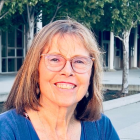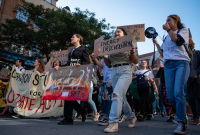Support strong Canadian climate journalism for 2025
These in-their-own-words pieces are told to Patricia Lane and co-edited with input from the interviewee for the purpose of brevity.
Paige Hunter is using art to make climate change more accessible. She was named a Starfish Canada Top 25 under 25 Environmental Activist, in part for co-founding the Sword Fern Collective, which holds free public events in Vancouver and Burnaby, B.C., allowing audiences to engage with local artists while exploring climate change issues.
Tell us about your project.
At our event in February at a community hall, 85 members of the public enjoyed a performance by a string quartet of local musicians playing composer Caroline Shaw’s nature-inspired Plan and Elevation. Then they broke into small groups and shared their own past experiences of art inspiring or moving them to action. This was followed by an improvised collective creation of a musical accompaniment to a collage of photos, film clips and videos assembled by the Sword Fern Collective, which included instruments, voice and audience dance and movement.
I am a musician and artist. I am also a climate activist. When I make or consume art, I feel so connected to my community and the natural world that I am able to transcend the fear and fact-based culture of climate change awareness. I want to share this significant key to my resilience.
Some of the stories people told of their experiences using art to great effect in the civil rights and peace movements are really inspiring. Some labour songs, for example, are still used today because they’re so effective at getting people to act.
In June, we will offer a similar event featuring spoken and written words from local creatives. By next year, we hope to have expanded to Montreal. You can stay up-to-date on the work of the Sword Fern Collective by following us on Instagram (@swordfernco) and subscribing to our newsletter, Rerooting, Rerouting.
How did you get into this work?
I became engaged with protecting the environment when I was a very young child probably inspired by nature documentaries. In high school, I joined the green team because it provided an avenue to make a collective effort. As a Simon Fraser University student, I was active in SFU350 in its successful campaign to persuade the Board of Governors to commit to divest from oil, gas and coal. I also helped develop a climate change course for all students, staff and faculty at SFU. I enjoyed this work but we have to involve more people. Our events at the Sword Fern Collective combine art, climate education, community building and action, and I hope to appeal to a broad cross-section.

How did the way you were raised impact your work?
My mum is passionate about animal well-being and my dad most often worked outside tree planting and in parks, for example. Both of them were effective union organizers. I learned early that solidarity and showing up are both crucial if you want something to change.
In my home community of Langley, British Columbia, there is a marked divide between rural and urban dwellers. I always thought that was sad, and I seek to build bridges to bring people together. Sometimes art can be a pathway to peace.
What makes your work hard?
Burnout is a real thing. My friends and I feel the urgency and desire to do everything perfectly and immediately, which can lead to a lot of anxiety. It is a hard lesson to learn that we have to put our own health first to stay in this for the long term.
What keeps you awake at night?
It is so frustrating that vast amounts of money are spent slowing us down and trying to stop climate action when all we want is a planet that is fit for all.
What gives you hope?
There are so many people doing such a wide range of things. I see more spent resourcing young people. I see more climate jobs opening up. I like knowing you can do anything and it can be climate work. I especially love learning about climate solutions that solve other wicked problems. For example, if we improve biodiversity in our parks, we enhance the availability of cooling spaces during extreme heat events.
What would you like to say to other young people?
Try to see others who have the same idea as you as a validation of your creativity and an opportunity for joyful collaboration rather than fearful competition.
What about older readers?
It is true there are a lot of young people in the climate space but we need you, too. The 2,500 Swiss senior women who gave their time to participate and win in the European High Court are an inspiration to us all.
Lots of older people ask what happened to the student strikes. But what about the peace movement? We need the energy of the 100,000 people who participated in the Vancouver peace marches and the many more who engaged in collective action to improve working conditions in labour strikes of the past.







Comments